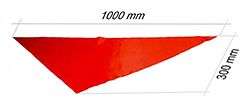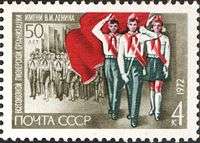Red scarf




| Wikimedia Commons has media related to Red scarves. |
The red scarf is a neckerchief worn by Young Pioneers of several countries during the socialist (“communist”) era. In the Soviet Union it was known as pionerskiy galstuk (пионерский галстук, i. e. pioneer’s neckerchief), in Vietnam as khăn quàng đỏ (red scarf), in China as hong lingjin (紅領巾, red scarf), in Cuba as pañoleta roja (red scarf), in Hungary as úttörőnyakkendő (pioneer’s neckerchief). Blue scarves were also used by youngsters before coming of age to wear the red one, and are still seen in some countries.
It remains in use by the Young Pioneers of China, Vietnam, North Korea and Cuba, and — unofficially, on occasions — in many other countries, such as Russia, Belarus, Ukraine, Finland etc. In China, the scarf is emblematic of blood of revolutionary martyrs, as recalled in Red Scarf Park and the title of Red Scarf Girl by Ji-li Jiang about her experiences during the Cultural Revolution. In Cuba, the scarf is worn by schoolchildren from first to sixth grade.[1]
Other users
A red scarf was introduced into the Republic of Korea Air Force as a device to aid visual location of downed South Korean airmen, it became and remains an iconic item of uniform in the Republic of Korea Air Force.[2]
References
- ↑ Teens in Cuba Sandy Donovan, Sujay Rao, Alexa L. Sandmann - 2008 "Cuban students usually join the Pioneers in first grade. When a child joins, there is a formal ceremony where the Young Pioneers neckerchief is presented. First-graders receive a red scarf, which they wear through sixth grade. In seventh ..."
- ↑ Kim, Hyo-jin (3 February 2015). "Former Air Force chief of staff dies at 91". The Korea Times. Retrieved 4 April 2015.